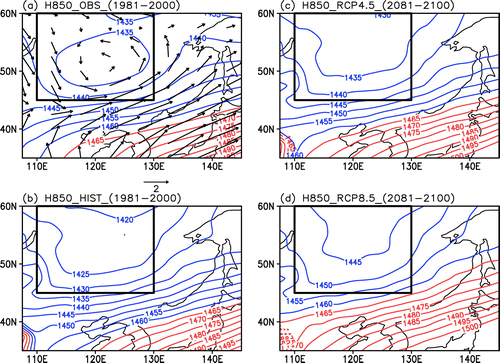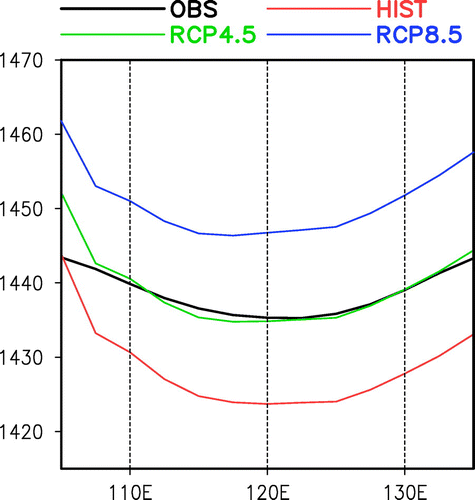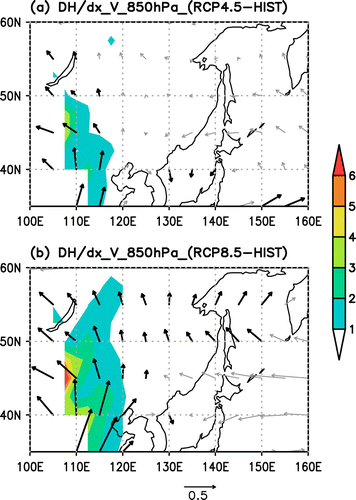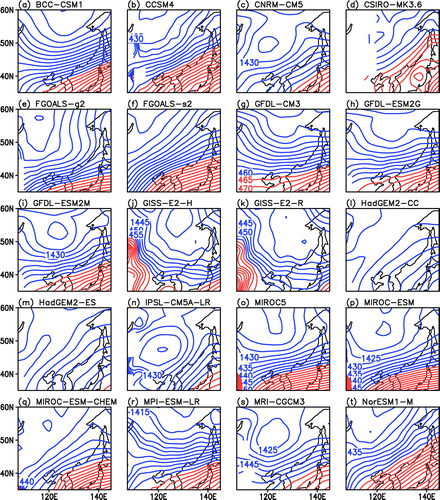Abstract
The East Asian summer climate is modulated by a low-pressure system over northern East Asia (NEAL) and a subtropical high over the western North Pacific. Many studies have focused on the subtropical high, but little is known about NEAL, especially its change in the future under global warming scenarios. This study investigates the projected change in NEAL in the late twenty-first century, using the outputs of 20 models from Phase 5 of the Coupled Model Intercomparison Project — specifically, their historical climate simulations (HIST) and future climate projections under the Representative Concentration Pathway 4.5 (RCP4.5) and 8.5 (RCP8.5) scenarios. The results show that the models capture the NEAL well in HIST. The NEAL is weakened in the late twenty-first century under the two RCP scenarios, with a stronger weakening under RCP8.5 than under RCP4.5. The weakened NEAL increases the geopotential height zonal gradient in the west and causes a southerly anomaly, which may bring more moisture and rainfall to northern East Asia.
摘要
东亚夏季气候受到东北亚低压和西北太平洋副热带高压的调制,但目前对于东北亚低压,特别是其在全球变暖下的变化及其影响所知甚少。本文对比CMIP5的20个模式的历史气候模拟、RCP4.5和8.5两种未来典型浓度路径下模拟试验的结果,预估了东北亚低压在21世纪末的变化特征。结果显示预估的东北亚低压强度在21世纪末将减弱,并且在RCP8.5情景下其强度减弱更为明显;对应东北亚低压减弱,低压西侧出现异常南风,导致更多的水汽向北输送到东北亚地区,有利于未来该地区降水的增加。
1. Introduction
The East Asian summer monsoon is modulated by a meridional land–sea thermal contrast between northern East Asia (NEA) and the western North Pacific (Han and Wang Citation2007; Lin Citation2014; Du, Lin, and Lu Citation2017), in addition to a planetary-scale thermal contrast between the Asian continent and North Pacific in the zonal direction (Guo Citation1983; Shi and Zhu Citation1996; Zhao and Zhou Citation2005; Zhu et al. Citation2005). The meridional thermal contrast is depicted by a low over continental northern East Asia (NEAL) and a subtropical high over the western North Pacific (Du, Lin, and Lu Citation2016; Lin and Wang Citation2016). Therefore, understanding the variability of the NEAL and the western North Pacific subtropical high is vital for predicting change in the East Asian summer climate. Many studies have investigated the variability of the subtropical high and its impact on East Asian summer climate (e.g. Chang, Zhang, and Li Citation2000; Lu Citation2001; Sui, Chung, and Li Citation2007; Lu and Fu Citation2010; Yeo, Jhun, and Kim Citation2012; He et al. Citation2015); however, little attention has been paid to the NEAL, especially its change under global warming.
Kamae et al. (Citation2014a) investigated the summertime land–sea thermal contrast over East Asia under global warming. Their results showed an enhanced thermal contrast over East Asia, characterized by a warmer tropospheric temperature over continental East Asia compared to over ocean areas. The enhanced land–sea thermal contrast leads to a weakening of orthogonal winds and an eastward retreat of the western North Pacific subtropical high (He et al. Citation2015). Meanwhile, the enhanced land–sea thermal contrast, especially the warming in continental East Asia induced by the increase in greenhouse gases (Zhu et al. Citation2012; Kamae et al. Citation2014b), may also change the intensity of NEAL (Du, Lin, and Lu Citation2016). Therefore, the projected change in NEAL under global warming is investigated in this study.
2. Data
We use the results of 20 models from Phase 5 of the Coupled Model Intercomparison Project (CMIP5) – specifically, their historical climate simulations (HIST) and their future climate change simulations under the Representative Concentration Pathway 4.5 (RCP4.5) and 8.5 (RCP8.5) scenarios. Table lists the resolutions of these models, and further details are documented online (https://cmippcmdi.llnl.gov/cmip5/index.html?submenuheader50). The 1981–2000 climatology in HIST is used as the baseline. The simulations for the period 2081–2100 under the RCP4.5 and RCP8.5 scenarios are used for the future projections under global warming. All the data are interpolated linearly onto a grid with a spatial resolution of 2.5° × 2.5°. The multi-model ensemble (MME) is obtained by simply averaging over the 20 models with equivalent weight.
Table 1. Descriptions of the models used in this study.
Also used are the reanalysis data derived from the National Centers for Environmental Prediction/National Center for Atmospheric Research (NCEP/NCAR) for the period 1948–2015 (Kalnay et al. Citation1996). The NCEP/NCAR data are used to evaluate the models’ abilities in representing the observations. Summer refers to the mean of June, July, and August.
3. Results
3.1. Evaluation of the NEAL in HIST
Figure (a) and (b) show the averaged summer geopotential height at 850 hPa (H850) during 1981–2000 in the NCEP/NCAR reanalysis data and MME in HIST, respectively. The NEAL, associated with cyclone circulation, is identified in the observation (Figure (a)), similar to that found in Lin and Wang (Citation2016) and Du, Lin, and Lu (Citation2016). The NEAL is also captured well in HIST, with a low-pressure trough centered over (45°–60°N, 110°–130°E), which is referred to as the NEAL core region. The intensity is a little stronger than that observed, with an averaged H850 over the NEAL core region of 1425 and 1436 gpm for the HIST MME and observations, respectively. Similar results are also obtained in HIST for each individual model, with low H850 over northern East Asia (Figure ), indicating the existence of NEAL in the models.
Figure 1. Summer (June–July–August) mean geopotential height at 850 hPa (H850; units: gpm) during 1981–2000 based on (a) the NCEP/NCAR reanalysis data and (b) the HIST MME. Vectors in (a) depict the summer-mean horizontal winds at 850 hPa during 1981–2000 based on the NCEP/NCAR reanalysis data. (c, d) As in (b), but during 2081–2100 under (c) RCP4.5 and (d) RCP8.5. The box depicts the NEAL core region.

3.2. Projected NEAL in the late twenty-first century under RCP4.5 and RCP8.5
The NEAL is also identified in the late twenty-first century (2081–2100) under both RCP4.5 (Figure (c)) and RCP8.5 (Figure (d)). A low trough is clear over northern East Asia, similar to that during the late twentieth century in HIST (Figure (b)) and observations (Figure (a)). The averaged H850 over the NEAL core region is 1436 gpm under RCP4.5 and 1447 gpm under RCP8.5, which is an increase of 11 and 22 gpm, respectively, compared with the value of 1425 gpm in HIST. The projected changes in NEAL can also be found in the meridional average of H850 between 45°N and 60°N under the two scenarios (Figure (a)), which shows the projected increase in H850 under the two RCP scenarios in comparison with that in HIST. However, the increased geopotential height over the northern East Asian region is probably attributable to a systematic global geopotential height increase due to global warming, according to the hydrostatic equation (Yang and Sun Citation2003; He et al. Citation2015; Wu and Wang Citation2015), and may not represent the changes in NEAL under global warming. Several studies have proposed using an eddy component, in which the zonal mean is subtracted, to represent the western North Pacific high at 500 hPa (Zhou et al. Citation2009; He et al. Citation2015; Huang et al. Citation2015; Wu and Wang Citation2015). However, this approach is incapable of depicting the lower-tropospheric NEAL (Du, Lin, and Lu Citation2016) due to missing values below 700 hPa within the Mongolian highlands and the Rocky Mountains in the midlatitudes of the Northern Hemisphere.
Figure 3. The NEAL trough, which is depicted by averaged H850 (units: gpm) over 45°–60°N, during 1981–2000, in the NCEP/NCAR reanalysis data (black line) and HIST MME (red line), as well as during 2081–2100 under RCP4.5 (green line) and RCP8.5 (blue line).

In this study, to remove the systematic H850 increase, we use a slope of the NEAL trough to measure the NEAL intensity. As shown in Figures and , NEAL is centered at 120°E in HIST and under both future scenarios. Therefore, the slope of the NEAL trough can be simply calculated as the difference between the H850 averaged over 45°–60°N along the trough at 120°E and those 10° away in the east and west directions, respectively, i.e. along 110°E and 130°E:
The systematic increase in H850 at 120°E is then offset by those at 110°E and 130°E. A larger negative slope represents a stronger NEAL trough. The slope is −5.5 gpm per 10° in HIST, and −5.0 and −4.7 gpm per 10° under RCP4.5 and RCP8.5 (Table ). The slope increases by 0.5 gpm per 10° under RCP4.5 and by 0.8 gpm per 10° under RCP8.5, relative to that in HIST. That is, the projected NEAL intensity decreases in the future, with a stronger weakening under RCP8.5 than that under RCP4.5. We further examine the individual changes in the NEAL trough in the 20 models under the two RCP scenarios from that in HIST. There are 12 models under RCP4.5 and 14 models under RCP8.5 in which the NEAL trough is weakened, suggesting a more consistent weakening of NEAL under RCP8.5 than under RCP4.5. Similarly, the NEAL slope depicted by the difference between the averaged H850 over 45°–60°N along 120°E and those along 105°E and 135°E is also calculated. The results are similar, with MME slopes of −14.8, −13.4, and −12.9 gpm per 15° in HIST, RCP4.5, and RCP8.5, respectively (Table ), indicating a weakened NEAL in the future, with a stronger weakening under RCP8.5 than under RCP4.5.
Table 2. Slope of the NEAL trough (units: gpm).
3.3. Possible impact of the change in NEAL on the East Asian summer monsoon
Previous studies have reported the importance of NEAL in affecting the summer monsoon and rainfall in East Asia (Lin and Wang Citation2016; Du, Lin, and Lu Citation2017). But how will the East Asian summer monsoon change as the NEAL weakens under global warming? Figure (a) shows the projected changes in winds at 850 hPa under the RCP4.5 scenario. A significant southerly anomaly is seen over northern East Asia, especially in the west around 110°E. Meanwhile, a similar but stronger southerly anomaly is also identified under the RCP8.5 scenario (Figure (b)).
Figure 4. Projected change in the geopotential height zonal gradient (shading; units: gpm per 5°) and horizontal winds (vectors; units: m s−1) at 850 hPa under (a) RCP4.5 and (b) RCP8.5 during 2081–2100, relative to those during 1981–2000 in HIST. Black thick vectors depict significant anomalies of meridional winds at 850 hPa at the 95% confidence level.

The southerly anomaly is attributable to the weakening of NEAL. As the NEAL weakens, the zonal gradient of H850 increases in the west under the RCP4.5 scenario (Figure (a)). According to the geostrophic balance, a southerly anomaly occurs. A similar conclusion is also obtained under the RCP8.5 scenario, with a stronger southerly anomaly (Figure (b)) associated with a stronger weakening of the NEAL (Table ). On the other hand, since the NEAL can also be viewed as a cyclonic circulation system, the suppressed northerly in the west of NEAL indicates a weakening of the cyclonic circulation over northern East Asia, which in turn confirms that the NEAL is weakened under global warming.
The southerly anomaly is opposite to the climatological northerly in the west of the NEAL (Figure (a)), suggesting a retreat of the climatological northerly in northern East Asia. Accordingly, the East Asian summer southwesterly may extend northwards and bring more moisture and rainfall to northern East Asia (figure not shown). The increase in rainfall over northern East Asia under global warming has also been reported in previous studies (Hsu et al. Citation2012; Qu, Huang, and Zhou Citation2014). We therefore conclude that a weakened NEAL, to a certain extent, is responsible for the increased rainfall over northern East Asia under global warming.
4. Summary and discussion
The projected change in NEAL is investigated in this study by analyzing the HIST, RCP4.5 and RCP8.5 outputs of 20 CMIP5 models. The results show that the models can capture NEAL well in HIST, with a low H850 trough over northern East Asia during 1981–2000. The NEAL intensity is weakened in the late twenty-first century under both RCP4.5 and RCP8.5, with a stronger weakening under the latter. The weakened NEAL increases the H850 zonal gradient in the west, causes a southerly anomaly, and suppresses the climatological northerly. Accordingly, the East Asian summer southwesterly may extend more northwards and bring more moisture and rainfall to northern East Asia.
This study shows that the NEAL weakens under global warming. The weakened NEAL is probably induced by surface warming over northern East Asia, especially around the Lake Baikal region (Xu, Zhu, and He Citation2011; Du, Lin, and Lu Citation2016). Based on simulation results with a prescribed surface warming around Lake Baikal in a linear baroclinic model, Du, Lin, and Lu (Citation2016) presented an increased H850 over northern East Asia in summer, which suppressed the NEAL intensity. The reported surface warming over northern East Asia under global warming (Zhu et al. Citation2012; Kamae et al. Citation2014a), therefore, may explain the weakening of the NEAL presented in this study.
Disclosure statement
No potential conflict of interest was reported by the author.
Funding
This study was supported by the National Natural Science Foundation of China [grant number 41375086], [grant number 41305063].
Acknowledgements
The authors thank the two reviewers for their valuable comments and suggestions, and also thank Prof. Riyu LU for suggestions and Dr Yi DAI for help with the plots during the preparation of the manuscript.
References
- Chang, C., Y. Zhang, and T. Li. 2000. “Interannual and Interdecadal Variations of the East Asian Summer Monsoon and Tropical Pacific SSTs. Part I: Roles of the Subtropical Ridge.” Journal of Climate 13 (24): 4310–4325.10.1175/1520-0442(2000)013<4310:IAIVOT>2.0.CO;2
- Du, M., Z. Lin, and R. Lu. 2016. “Inter-decadal Change in the Summertime Northeast Asia Low-pressure System in the Early 1990s (in Chinese).” Chinese Journal of Atmospheric Sciences 40 (4): 805–816.
- Du, M., Z. Lin, and R. Lu. 2017. “Combined Impact of in-Phase and out-of-Phase Variation between the Northern East Asian Low and Western North Pacific Subtropical High on East Asian Summer Rainfall.” Atmospheric and Oceanic Science Letters 10: 284–290. doi:10.1080/16742834.2017.1312262.
- Guo, Q. 1983. “The Summer Monsoon Intensity Index in East Asia and Its Variation.” Acta Geographica Sinica 38: 207–217.
- Han, J., and H. Wang. 2007. “Interdecadal Variability of the East Asian Summer Monsoon in an AGCM.” Advances in Atmospheric Sciences 24: 808–818.10.1007/s00376-007-0808-0
- He, C., T. Zhou, A. Lin, B. Wu, D. Gu, C. Li, and B. Zheng. 2015. “Enhanced or Weakened Western North Pacific Subtropical High under Global Warming?” Scientific Reports 5: 16771. doi:10.1038/srep16771.
- Hsu, P., T. Li, J.-J. Luo, H. Murakami, A. Kitoh, and M. Zhoa. 2012. “Increase of Global Monsoon Area and Precipitation under Global Warming: A Robust Signal?” Geophysical Research Letters 39: L06701. doi:10.1029/2012GL051037.
- Huang, Y., H. Wang, K. Fan, and Y. Gao. 2015. “The Western Pacific Subtropical High after the 1970s: Westward or Eastward Shift?” Climate Dynamics 44: 2035–2047.10.1007/s00382-014-2194-5
- Kalnay, E., M. Kanamitsu, R. Kistler, W. Collins, D. Deaven, L. Gandhin, M. Iredell, et al. 1996. “The NCEP/NCAR 40-year Reanalysis Project.” Bulletin of the American Meteorological Society 77 (3): 437–471.10.1175/1520-0477(1996)077<0437:TNYRP>2.0.CO;2
- Kamae, Y., M. Watanabe, M. Kimoto, and H. Shiogama. 2014a. “Summertime Land–Sea Thermal Contrast and Atmospheric Circulation over East Asia in a Warming Climate – Part I: Past Changes and Future Projections.” Climate Dynamics 43 (9–10): 2553–2568.10.1007/s00382-014-2073-0
- Kamae, Y., M. Watanabe, M. Kimoto, and H. Shiogama. 2014b. “Summertime Land–Sea Thermal Contrast and Atmospheric Circulation over East Asia in a Warming Climate – Part II: Importance of CO2-Induced Continental Warming.” Climate Dynamics 43 (9–10): 2569–2583.10.1007/s00382-014-2146-0
- Lin, Z. 2014. “Intercomparison of Impacts of Four Summer Teleconnections over Eurasia on East Asian Rainfall.” Advances in Atmospheric Sciences 31 (6): 1366–1376.10.1007/s00376-014-3171-y
- Lin, Z., and B. Wang. 2016. “Northern East Asian Low and Its Impact on the Interannual Variation of East Asian Summer Rainfall.” Climate Dynamics 46 (1): 83–97.10.1007/s00382-015-2570-9
- Lu, R. 2001. “Interannual Variability of the Summertime North Pacific Subtropical High and Its Relation to Atmospheric Convection over the Warm Pool.” Journal of the Meteorological Society of Japan 79 (3): 771–783.10.2151/jmsj.79.771
- Lu, R., and Y. Fu. 2010. “Intensification of East Asian Summer Rainfall Interannual Variability in the Twenty-first Century Simulated by 12 CMIP3 Coupled Models.” Journal of Climate 23: 3316–3331. doi:10.1175/2009JCLI3130.1.
- Qu, X., G. Huang, and W. Zhou. 2014. “Consistent Responses of East Asian Summermean Rainfall to Global Warming in CMIP5 Simulations.” Theoretical and Applied Climatology 117: 123–131.10.1007/s00704-013-0995-9
- Shi, N., and Q. Zhu. 1996. “An Abrupt Change in the Intensity of the East Asian Summer Monsoon Index and its Relationship with Temperature and Precipitation Over East China.” International Journal of Climatology 16: 757–764.10.1002/(ISSN)1097-0088
- Sui, C.-H., P.-H. Chung, and T. Li. 2007. “Interannual and Interdecadal Variability of the Summertime Western North Pacific Subtropical High.” Geophysical Research Letters 34: L11701. doi:10.1029/2006gl029204.
- Wu, L., and C. Wang. 2015. “Has the Western Pacific Subtropical High Extended Westward since the Late 1970s?” Journal of Climate 28: 5406–5413.10.1175/JCLI-D-14-00618.1
- Xu, K., C. Zhu, and J. He. 2011. “Impact of the Surface Air Warming around the Lake Baikal on Trend of Summer Precipitation in North China in the past 50 Years.” Plateau Meteorology 30: 309–317.
- Yang, H., and S. Sun. 2003. “Longitudinal Displacement of the Subtropical High in the Western Pacific in Summer and Its Influence.” Advances in Atmospheric Sciences 20: 921–933.
- Yeo, S.-R., J.-G. Jhun, and W. Kim. 2012. “Intraseasonal Variability of Western North Pacific Subtropical High Based on the El Niño Influence and Its Relationship with East Asian Summer Monsoon.” Asia-Pacific Journal of Atmospheric Sciences 48 (1): 43–53.10.1007/s13143-012-0005-7
- Zhao, P., and Z. J. Zhou. 2005. “East Asian Subtropical Summer Monsoon Index and Its Relationships to Rainfall.” Acta Meteorologica Sinica 23 (1): 18–28.
- Zhou, T., R. Yu, J. Zhang, H. Drange, C. Cassou, C. Deser, D.L.R. Hodson, et al. 2009. “Why the Western Pacific Subtropical High Has Extended Westward since the Late 1970s.” Journal of Climate 22: 2199–2215.10.1175/2008JCLI2527.1
- Zhu, C., W.-S. Lee, H. Kang, and C.-K. Park. 2005. “A Proper Monsoon Index for Seasonal and Interannual Variations of the East Asian Monsoon.” Geophysical Research Letters 32 (2): L02811. doi:10.1029/2004gl021295.
- Zhu, C., B. Wang, W. Qian, and B. Zhang. 2012. “Recent Weakening of Northern East Asian Summer Monsoon: A Possible Response to Global Warming.” Geophysical Research Letters 39 (9): L09701. doi:10.1029/2012gl051155.

